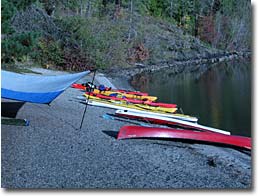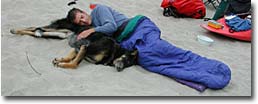Multiday Kayaking Trips
With proper planning and packing, multiday trips in kayaks are very doable. Boaters are using a wide variety of whitewater kayaks and touring/rec boats to explore inland and offshore waters.
 Today’s whitewater playboats are too low-volume to carry extra gear, but many creek boats can accommodate overnight gear. Touring/rec boats are much higher volume craft and often have watertight compartments.
Today’s whitewater playboats are too low-volume to carry extra gear, but many creek boats can accommodate overnight gear. Touring/rec boats are much higher volume craft and often have watertight compartments.
This type of multiday boating requires you to think more like a backpacker, choosing gear that’s compact and light in weight. In this piece, we’ll discuss some of the things you need to consider when preparing for that overnight trip. Please refer to the NRS Gear Checklists for specific recommendations on individual items to bring. If traveling on water that is permitted or regulated by a government agency, check ahead to see what items they require.
Getting Organized
Convene your group well before the trip to discuss arrangements for meals, transportation and shuttles, costs, and group equipment and responsibilities. You may want to collect non-refundable deposits to minimize those last minute back-outs that complicate logistics and expenses.
The key to a successful multiday trip is good prior planning. If you’re going to be exploring a new stretch of water, talk to others who’ve boated it, and shop for up-to-date guidebooks and maps. Break the trip into distances that can easily be achieved in a normal day’s paddle, and allow for unexpected weather.
Camp Gear
 Items you’ll need to consider include a sleeping bag, sleeping pad, tent or tarp shelter, stove, matches and lighter, pots and pans, and utensils. Also you’ll need a couple of water bottles and a good drinking water filter. A travel chair, like the Crazy Creek, makes sitting in camp more comfortable.
Items you’ll need to consider include a sleeping bag, sleeping pad, tent or tarp shelter, stove, matches and lighter, pots and pans, and utensils. Also you’ll need a couple of water bottles and a good drinking water filter. A travel chair, like the Crazy Creek, makes sitting in camp more comfortable.
Packing out solid human waste is a challenge for kayakers. The Cleanwaste Portable Toilet System Wag Bags are ideal for your use. The Wag Bags can be adapted to a compact container or just placed in a depression in the ground. The patented gelling system solidifies the waste. Place the bag containing the waste in the supplied storage bag, which can then be legally placed in any household garbage can after your trip.
Food for the Trip
Again, you need to think like a backpacker. Even though you’re not packing it on your back, weight and bulk are a factor. There are many quality freeze-dried meals on the market, and you can adapt any dry supermarket packaged mix that can be prepared on a stovetop. Fresh foods can be packed for the first couple of days. If you have room for a small soft cooler, you can extend the time for fresh meat and produce by freezing as much of the food as possible and using that to keep the other items cool. Some canned beverages can be frozen and thawed successfully; experiment at home first.
Packing Your Gear
 You’ll want suitable dry bags for storing and protecting your food and gear (keep in mind that the hatch of your kayak may not keep water out completely). Dry bags come in a range of sizes and types, depending on your selection of gear. It’s best to pack things in a number of smaller bags, making fitting things in the confined space easier.Aquapac makes a complete line of bags for protecting your camera, GPS, radio, etc. It’s a good idea to bring a lightweight duffel bag for packing items up to the campsite.
You’ll want suitable dry bags for storing and protecting your food and gear (keep in mind that the hatch of your kayak may not keep water out completely). Dry bags come in a range of sizes and types, depending on your selection of gear. It’s best to pack things in a number of smaller bags, making fitting things in the confined space easier.Aquapac makes a complete line of bags for protecting your camera, GPS, radio, etc. It’s a good idea to bring a lightweight duffel bag for packing items up to the campsite.
Pack heavier items (like food, water and fuel) as low and as close to the middle of the boat as possible. Lighter items (like clothing and sleeping bag) can be packed on top and toward the ends of the boat.
When your boat is packed for overnight trips, it will handle very differently. If possible, load the boat and take a preliminary short spin to work out the best balance for your load.
Safety Items
A headlamp and medical kit are essential for any type of trip. Know how to use the medical kit; organizations like the Red Cross offer first aid and CPR classes. It’s good to carry a space blanket or bivvy sack in case someone gets dangerously cold and needs an emergency warm-up. A spare paddle is also highly recommended. Touring boaters should include a strobe light, especially in big, open water. A deck-mounted compass,paddle float, paddle leash and possibly a short-wave radio (depending on the distance you plan to paddle, the geographical location, and your familiarity with the route) are good additions for the touring boater.
Keeping both air and water temperatures in mind, consider including some combination of the following: a drysuit, drytop, drypant, wetsuit, splash-jackets, splash pant, neoprene gloves and suitable footwear. As with most outdoor sports, layering is the name of the game for kayaking. This gear can do double duty for protection in camp and on side hikes.
Multiday trips, especially those in remote areas, offer unique challenges and rewards. Do your homework, prepare for emergencies and don’t tackle water beyond your experience level.
Boat safe, have fun—see you on the water!
 NRS Gift Card: Always Fits, Always Wanted
NRS Gift Card: Always Fits, Always Wanted




